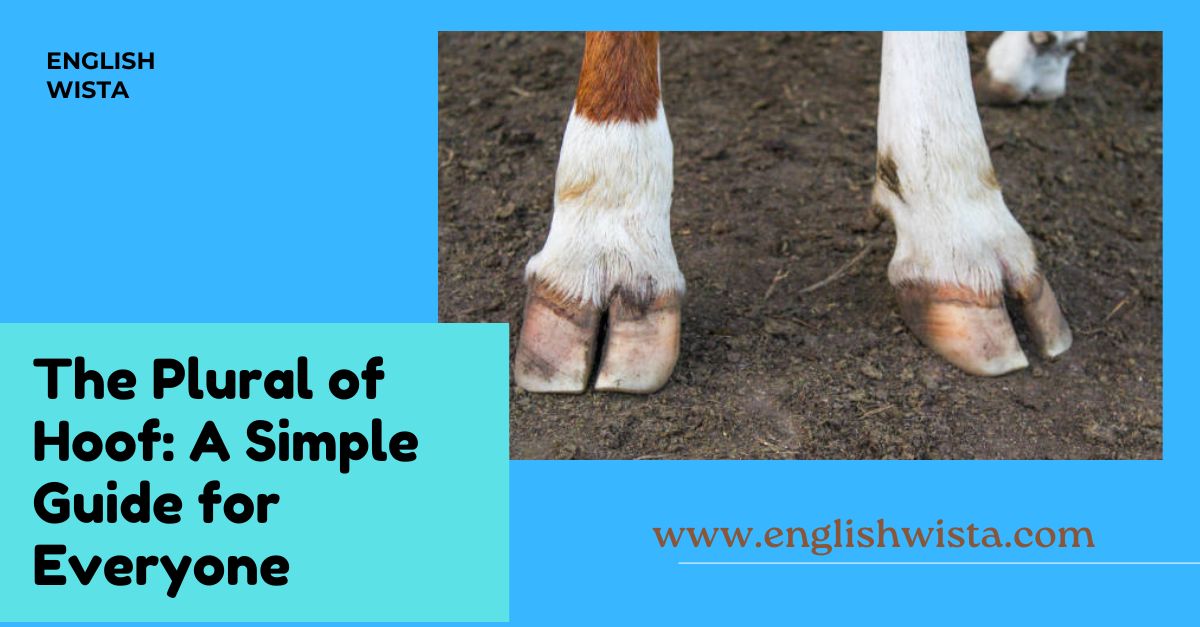Have you ever paused while writing or speaking and wondered, “Wait… is it hoofs or hooves?” Don’t worry you’re not alone! English can be a little tricky when it comes to plurals, and hoof is one of those words that makes many people second-guess themselves. If you’ve seen both versions in books or online, it’s because both are actually correct.
In this article, we’ll explore everything you need to know about the plural of hoof. We’ll keep things simple, friendly, and clear so that even if English isn’t your first language, you’ll walk away with confidence. By the end, you’ll not only know the right plural forms but also understand when and how to use them. Let’s dive in!
What Does “Hoof” Mean?
Before we look at the plural, let’s make sure we’re clear on the word itself.
A hoof is the hard covering at the bottom of the feet of animals like horses, cows, deer, goats, and sheep. It’s like a natural shoe that protects their feet and helps them walk, run, or even climb.
So, if you see a horse, each of its four feet has a hoof. That means one horse has four hooves (or four hoofs, but more on that soon).
What Is the Plural of Hoof?
Here’s the direct answer you’ve been waiting for:
The plural of hoof can be written in two ways:
- Hoofs
- Hooves
Both are correct. That’s right you can use either one, and people will understand you.
But here’s the catch: hooves is more common in everyday use, especially in modern English. If you’re talking about horses or reading animal stories, chances are you’ll see hooves more often. Hoofs is less common today but still accepted, especially in scientific or historical writing.
Why Are There Two Plurals?
Good question! The answer has to do with how English has changed over time.
- Long ago, many words in English formed their plurals with a vowel change inside the word. This is called an “irregular plural.” For example:
- tooth → teeth
- foot → feet
- goose → geese
- Hoof followed this old pattern, which is why hooves became common.
- However, English also has a simple and regular way of making plurals just add -s. That’s where hoofs comes from.
So today, both versions exist side by side.
Which Plural Should You Use?
Here’s a simple way to think about it:
- Hooves → Most common in everyday English, stories, and casual conversation.
- Hoofs → Sometimes used in formal, scientific, or older writing.
If you’re writing an essay, a story, or just chatting with friends, hooves is the safer choice. It’s the form that sounds most natural to most people.
Example Sentences with “Hooves”
Let’s look at how hooves appears in real sentences:
- The horse’s hooves made a steady sound on the cobblestone road.
- Cows leave deep marks in the soil with their heavy hooves.
- The deer’s hooves were so light that it barely made a sound while running.
- The blacksmith carefully shaped new shoes for the horse’s hooves.
Example Sentences with “Hoofs”
And here are a few examples with hoofs:
- The archaeologist studied the fossilized hoofs of ancient animals.
- Farmers once wrote about the hoofs of cattle in their journals.
- Some textbooks in the past preferred hoofs over hooves.
Is Hoof Singular or Plural?
This is a question some learners ask. The word hoof is singular, which means it refers to just one. For example:
- A horse has one hoof lifted off the ground.
- That cow hurt its front hoof.
When you want to talk about more than one, that’s when you use hooves or hoofs.
How Do Other Animal Foot Words Work?
It can help to compare hoof with other animal-related words:
- Paw → paws (regular plural)
- Claw → claws (regular plural)
- Hoof → hoofs or hooves (two options!)
This shows why hoof feels a little unusual it’s one of the few words that lets you pick between a regular and irregular plural.
Origin of the Word Hoof
Let’s go a little deeper for those who enjoy word history.
The word hoof comes from Old English “hof,” which meant the foot of an animal. Over time, the spelling changed, but the meaning stayed the same. The irregular plural hooves developed naturally, just like teeth and feet. But as English became simpler, the regular plural hoofs also appeared and stuck around.
So the two forms today are like a mix of history and modern usage.
Fun Facts About Hooves
To keep things interesting, here are some fun facts you might enjoy:
- Horses’ hooves are made of the same material as human fingernails keratin.
- A horse’s hoof grows about one-quarter of an inch every month.
- Blacksmiths who work on horses’ hooves are called farriers.
- In some cultures, a horseshoe (which is nailed onto a horse’s hoof) is a symbol of good luck.
- Deer and goats have “cloven hooves,” which means their hooves are split into two parts.
Common Expressions with Hoof
The word hoof also shows up in some English phrases. Here are a few:
- On the hoof – This means something is done quickly or while moving, like “He made the decision on the hoof.”
- Hoof it – This is a casual way to say “walk” or “run.” For example, “We missed the bus, so we had to hoof it home.”
These fun expressions can make learning the word even more memorable!
How to Remember the Plural Easily
Here’s a quick trick to make sure you never forget:
- If you’re writing or speaking casually, just go with hooves.
- If you’re reading something older or more formal, don’t be surprised if you see hoofs.
Think of it like this: hooves is the friendly everyday version, and hoofs is the more traditional cousin.
Comparing with Other Irregular Plurals
To reinforce the idea, let’s compare with some familiar words:
- Leaf → leaves (not leafs)
- Knife → knives (not knifs)
- Wolf → wolves (not wolfs)
- Hoof → hooves (or hoofs)
See the pattern? Many words ending in -f or -fe change to -ves in the plural. But the twist with hoof is that you can also keep it simple and just add -s.
Quick Practice Sentences
Try reading these aloud to see which form sounds better to you:
- The wild horses galloped, their hooves/hoofs thundering on the plain.
- The scientist recorded the size of the animals’ hooves/hoofs.
- Children laughed as they heard the clip-clop of the donkey’s hooves/hoofs.
In each case, both work. But if you noticed that hooves feels a bit more natural, you’re not alone!
Final Thoughts and Easy Takeaway
So, what have we learned? The word hoof has two correct plurals: hoofs and hooves. Most of the time, people prefer hooves in everyday language, but hoofs is still perfectly fine, especially in older or scientific contexts.
Here are the main points to remember:
- Hoof = singular
- Hooves/Hoofs = plural
- Hooves is more common today
- Both are correct, so you won’t be wrong with either one
English is full of quirks like this, but that’s what makes it fun to learn. Next time you’re talking about horses, cows, or deer, you’ll know exactly which plural to use.
And here’s the best part: whether you choose hooves or hoofs, people will understand you just fine.
Conclusion
The plural of hoof may seem confusing at first, but once you understand the history and the options, it’s actually pretty simple. Both hoofs and hooves are correct, though hooves is what you’ll hear most often today.
So don’t stress the next time you write or say it just pick the one that feels right for the moment. Think of it as one of English’s little gifts: a word with two valid choices.
And who knows? The next time you hear horses clip-clopping down a road or see deer tracks in the forest, you’ll probably smile and think, “Ah, those are the hooves… or hoofs!”



